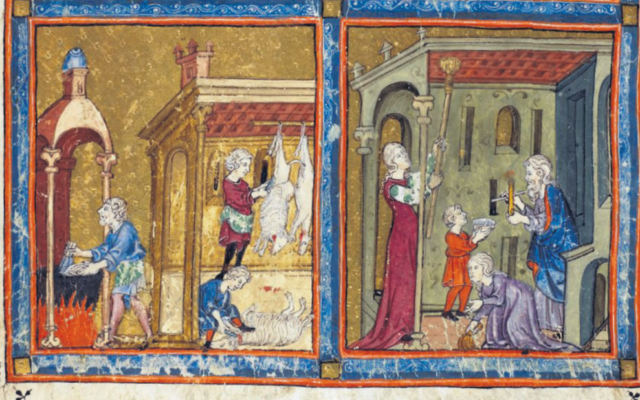The essence of the Pesach seder
There is the seder we will have – and one we recall.

From the far-flung Himalayas to the Old City of Jerusalem, every Jew in any way affiliated with Judaism will shortly have a seder. At the very least, they will have an evening get-together with some matzah and horseradish (or lettuce) and cups of wine.
But what is the essence of the seder to which our thoughts are now turning?
In his magnum opus, Halakhic Man, Rabbi Joseph B Soloveitchik suggests that the seder is best defined by Rambam in Yad Hachazakah (Mishenh Torah), his 12th century codification of law that serves to this day as one of the basic building blocks of the Shulchan Aruch, our code of Jewish law.
Rambam (Chametz u’Matzah 8:1) begins the laws of the seder as follows: “First a cup is mixed for each person and he recites the blessing ‘Boreh pri hagafen’.” Sound familiar? Of course. Every child who attends or attended any Jewish school knows that the order of the seder is kadesh, urchatz, etc.
But then Rambam continues in an unexpected manner: “And after he recites the blessing … a table is brought bearing bitter herbs, another vegetable, unleavened bread, charoset, the body of the paschal lamb and meat from the festival offering.”
To students of halachic literature, these lines are striking. Strangely, in his primary prescription of laws relating to seder night, Rambam did not set down what we do – or should do – in the contemporary exilic era of which he was part. Rather, he chose to describe, as factual, a seder centred around a paschal lamb. So we are instructed: “The second cup is mixed (they used to dilute very strong wine), and here the son asks the ‘Mah Nishtanah’.” However, it is an unfamiliar (but Mishnaic) version: “Why is this night different … on all other nights we eat meat roasted, stewed and boiled, on this night it is all roasted?”
The gastronomic element of the seder has no doubt contributed to its continued popularity. To this day, prescribed foods are still at its core, though sadly, not luscious lamb but just dry matzah and bitter maror. Eating matzah on this night fulfils a Torah prescription, while eating maror (in the absence of a paschal lamb) fulfils a rabbinic precept “zecher lemikdash” (in memory of the temple).
But why in a practical code does Rambam – the rationalist par excellence and, accordingly, very much part of the real world in which he lived – deal with the seder in the manner cited rather than simply outlining significant continuing contemporary obligations?
Answers Rabbi Soloveitchik, in writing this prescription of seder celebration – including the Mishnaic version of Mah Nishtanah – Rambam was discussing the ideal seder. He “was not referring to the innocent child of his day at his father’s table in Cairo or Cordoba. He was referring to the son who reclined at his father’s table in ancient Jerusalem, when the air resounded with the tones of Hallel recited over the eating of the paschal lamb”. For that very reason, Rambam continues by describing the blessings over the sacrificial meat and eating thereof.
But practical law is not forgotten. Suddenly Rambam changes tone. “In the present time,” he adds, “we do not say ‘tonight is all roasted’, for we do not have the paschal offering.” And, he continues, utilising that phrase again and again: “In the present time we add ‘So O Lord our God … bring us to other festivals … happy in the building of the city and joyous in thine service …’” Finally he adds: “In the present time, when there is no offering, he eats an olive’s bulk of matzah (our afikomen), and does not taste anything more after that.”
In so presenting the seder, Rambam teaches not only its essentials, but also a message resonating for all time.
Halachah prescribes what should be done – and then, because halachah is always applicable, it also prescribes how to act when circumstances prevent practice of its requirements in full. Just while we have so many mitzvot to fulfil on this night of nights, we are enjoined to remember that all we do today is only a historic anomaly in the ongoing process of actualisation of halachah in the real world.
So even as we lack that paschal lamb, contemporary Jewry universally observes on this night whatever it can – as Jewry worldwide has done for the last two millennia. We fulfil Torah-based injunctions to eat matzah and tell the story, together with the key rabbinic mitzvot, consuming maror and four cups of wine. Inevitably, however, while so doing we feel the absence of the crucial temple-based element of the ceremony. Hence, after the dry korech sandwich of matzah and maror, we eat an egg as a sign of mourning. By the way, Pesach is even connected to Tisha b’Av in that the seder night and the night we read Echah are on the same night of the week.
And it then comes as no surprise that we end the formal part of the seder with “l’shanah haba’ah b’Yerushalayim” (next year in Jerusalem), where the ceremonies of the seder and so much else of Torah will be fulfilled in their original format.
May it be bimhera beyamenu – speedily in our days!
Chag kasher v’sameach,
Yossi
Yossi Aron OAM is The AJN’s religious affairs editor.

comments